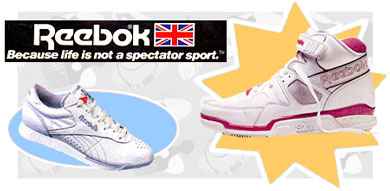Reeboks

Fashion Synopsis
While Nike and adidas were battling it out on the street, Reebok came up from behind and blew the athletic market away with its specialized aerobics shoes. Jogging was the craze of the 70’s, but while everyone was suited up in velour suits and a pair of Cortez Nikes, they forgot to notice the new fitness obsession that left the track for the dance studio.
British entrepreneur Joseph William Foster created hand-made running shoes in the 1890’s, and J.W. Foster and Sons became the shoe company responsible for the best running shoes around the world. Sixty years later, in 1958, two of Foster’s grandsons carried on the tradition when they started Reebok, fast shoes named after the speedy African gazelle.
At the cusp of the 70’s obsession with running, sporting goods representative Paul Fireman brought Reebok running shoes to the U.S. by acquiring the North American license. The shoes were sold for $60, the most expensive shoes on the market, considerably more than competitors Nike or adidas. Even with the high tab, Reeboks met with great success, but their real victory occurred just a few years later.
America’s passion for fitness went beyond pounding the pavement, and by the early 80’s a new craze came on board: aerobic dance. Aerobics wasn’t about running on a track or back on forth on a court. It was about moving and grooving to music, and old-fashioned running shoes were no longer good enough. Aerobicizers needed a lightweight shoe with good ankle support; they didn’t need speed, but they needed comfort.
Without Reebok, all that aerobicizing wouldn’t have been as fun or as safe. Regular running shoes were built for speed, but the Reebok Freestyle was built for fitness. Reebok’s boldly styled Freestyle hi-top sneaker was the first of its kind, and it was made specifically for women—the largest market of aerobicizers. Women around the world did the grapevine in leotards and legwarmers, and the Reebok Freestyle was on their feet.
In addition to classic white and black, Reeboks came in fashion colors like hot pink, lemon yellow and fire engine red. They were as fashionable on the street as they were in the gym. A pair of colored slouch socks, a bright pair of Freestyles, and you were ready to go. So come on, let’s get physical, but make sure you’ve got your Reeboks on.
Reebok did it again with Pump technology in the late 80’s, when the pump pushed Reebok from the aerobics studio to the court. Marketed as a premiere cross-training athletic shoe, the Pump was perfection whether running, jumping, or sprinting. Nike had already filled shoes with air pockets, but the Pump let the wearer decide how much air went in. Once the shoe was slipped on, you simply pushed a round pumping device repeatedly for a snug, perfect fit.
With an almost four billion dollar market, Reebok successfully made it to the next round of footwear fanaticism. Having captured fitness, they now specialize in athleticism, creating some of the most technologically advanced performance sneakers on the market.
Fashion Sub Categories
girl's apparelboy's apparel
shoes
brands
